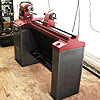Hi everyone, bit of a newbie here to the forum and woodworking for that matter.
I started out in the hobby just a couple years ago and had decided i would start w/ handtools. So i've spent the past 2 years acquiring handtools, learning to sharpen, learning to use them properly (via DVD's, books, 1 seminar w/ David Charlesworth @ LN, and just doing it).
I've done a few odd's and ends little projects and milled the wood from rough sawn lumber. I've gotten to the point though where I just want to work wood. I'm ready to buy the power jointer and planer I think. I am a weekend woodworker, so I spend a lot of time milling lumber.
I'm curious how many Neander's out there are still milling by hand or if most have crossed over to the power tool side. BTW, I do have a cabinet saw, so usually i'm flattening, jointing and edge by hand and then ripping to width on the TS. Then thickness by hand (or the dreaded TS resaw operation).
I am certainly not into the whole "Zen of woodworking" thing - I don't feel handtools are better, etc. I'm now more into the "what is the quickest, most efficient way to do it" mentality. Granted, since i lean towards neander, I believe if you learn to use handtools properly, there are many many operations that can be done quicker and more efficiently than power tools...but milling lumber? I'm thinking those power J&P's are pretty nice...
Cheers.




 Reply With Quote
Reply With Quote
 ). I have no interest in 4 squaring 100 bf of material, just not going to spend the time on it when I can take a couple hours with a tailed jointer and planer & table saw. I don't put a price on my time in my shop, but if I buy a truck load of lumber for $2 a bf and spend a month of weekends just prepping stock for a larger project, the price of the lumber isn't as "cheap" as it would have been IMO.
). I have no interest in 4 squaring 100 bf of material, just not going to spend the time on it when I can take a couple hours with a tailed jointer and planer & table saw. I don't put a price on my time in my shop, but if I buy a truck load of lumber for $2 a bf and spend a month of weekends just prepping stock for a larger project, the price of the lumber isn't as "cheap" as it would have been IMO.







